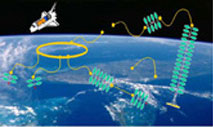This special field revolves around processes for modifying material properties (milling, cooling), composition (filtration, distillation) and type (oxidation, hydration).
Valuable information is available on a broad range of technologies including material separation, laser processes, measuring techniques and robot engineering in addition to testing methods and coating and materials analysis processes.

Through precise control of the etching process, an inventor in Oxford University’s Photofabrication Unit has made the reliable production of High Resolution Printed Circuit Boards (PCBs) with conductors down to 10 µm wide more of a cost-effective reality.
With increasing demands for greater miniaturisation and the use of flexible circuitry, the need for improved fabrication methods for high resolution printed circuit boards is becoming more important. PCBs currently include conductors with

Micro-sensors, developed by the CEIT Technology Centre with the help of Gas de Euskadi, operate by detecting gas leaks and reducing the risks of poisoning through the inhalation of carbon monoxide gas.
Through research involving help from Gas de Euskadi, CEIT has developed a system based on micro-sensors that can detect domestic gas leaks. The increasing use of natural gas in homes, the future regulations for carbon monoxide detection in domestic situations and the growing demand for

A unique University of Southern California design for self-organizing robots controlled by “hormonal” software is moving toward space.
At the Robosphere 2002 conference held at the NASA Ames Research Center in Silicon Valley November 14-15, Wei-Min Shen of the USC School of Engineering’s Information Sciences Institute (ISI) presented an overview of an audacious project to have pieces of the proposed half-mile-long Space Solar Power System satellite put themselves together–self-a

Penn State acousticians have achieved proof of concept for a compact ice cream freezer case based on “green” technology that substitutes sound waves for environment-damaging chemical refrigerants.
Dr. Steven Garrett, the United Technologies Corporation professor of acoustics at Penn State, leads the research team conducting the project with financial support from Ben & Jerry’s and its parent company, Unilever.
“In our proof-of-concept test system, there is no ’test freeze

The horse, a classic model of grace and speed on land, is now an unlikely source of inspiration for more efficient flight.
So says a group of University of Florida engineers who have recreated part of a unique bone in the horse’s leg with an eye toward lighter, stronger materials for planes and spacecraft.
The third metacarpus bone in the horse’s leg supports much of the force conveyed as the animal moves. One side of the cucumber-sized bone has a pea-sized hole whe

Process may lead to manufacture of nanoscale devices
A University at Buffalo engineer has developed a novel method for assembling nanoparticles into three-dimensional structures that one day may be used to produce new nanoscale tools and machines.
The work could be an important step in fulfilling the immense potential of nanotechnology because it gives scientists and engineers improved control and flexibility in the creation of materials for the manufacture of many nanoscale